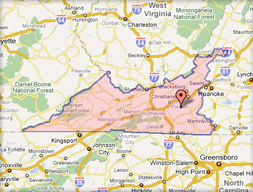| Boucher Holds Briefing on Greenhouse Gas Control Legislation (May 29, 2009) |
 |
 |
|
STATEMENT OF CONGRESSMAN RICK BOUCHER
May 29, 2009
Abingdon, Virginia
Last week, the U.S. House of Representatives Committee on Energy and Commerce approved legislation regulating greenhouse gas emissions. I supported approval of the measure because I believe the regulation to be necessary and because I believe that under its provisions the coal industry and the thousands of jobs in our region that coal provides will be secure.
The regulation of greenhouse gas emissions by the federal government is inevitable. The Supreme Court has declared that carbon dioxide is a pollutant, and under that holding as a practical matter the Environmental Protection Agency (EPA) is now required to regulate carbon dioxide emissions. The EPA is now preparing its own regulatory program. Our legislation will supersede the EPA's effort and preempt EPA from regulating CO2 in any manner inconsistent with the provisions of the legislation. Virtually all interested parties, from the business community to environmental groups would prefer to have the regulation written by Congress than by EPA.
In the months leading up to last week's committee action, I carried on an intensive negotiation with the chairman of the Energy and Commerce Committee, Henry Waxman of California. As a result of those negotiations, the bill approved by the committee contains key provisions which I had recommended to protect the coal industry, coal related jobs and to keep electricity prices affordable in regions such as Southwest Virginia where most of our electricity is produced by burning coal.
While Chairman Waxman and I successfully negotiated dozens of provisions in the legislation, the key concessions he made to me include the following: 1. My proposal to provide assured federal funding of $1 billion annually for the rapid development of carbon dioxide capture and sequestration technologies has been included in the legislation. Over a 10-year period, the $10 billion which this fund will produce, according to expert observation, will provide available, affordable and reliable carbon dioxide separation and storage technologies by 2020. These technologies will enable coal to be burned by power plants without emitting carbon dioxide, and their arrival will assure that coal will continue to be America's primary fuel for electricity generation.
2. I also ask for a special fund of between $75 and $100 billion, the exact value to be determined by then the current emission allowance prices, to assist with the cost of deploying carbon capture and sequestration technologies when they become available. This fund was also included in the legislation.
3. Essential to my support of the legislation was a third recommendation under which emission allowances be provided for free to the emitting entities rather than requiring that the allowances be purchased by them at government-sponsored auctions. Free allowances reduce the overall cost of the program helping to secure the role for coal and helping to keep electricity prices affordable in regions such as ours where most of the electricity is coal fired. That provision is also a part of the legislation approved by the committee.
4. Finally, to enable electric utilities to continue using coal while reducing greenhouse gas emissions in the time between the effective date of the law and 2020 when we anticipate carbon capture and sequestration technologies being available, the legislation contains my recommendation that 2 billion tons of carbon dioxide offsets be made available for purchase by emitters each year. In the typical case, instead of reducing emissions from coal-fired power plants at the plant site, the electric utility would pay for the planting of trees, the preservation of existing tropical rain forests or invest in domestic agriculture in a way which would reduce carbon dioxide emissions from farming operations. The availability of these offsets are the key to enabling electric utilities to continue using coal as they are today while at the same time meeting the carbon dioxide reduction requirements contained in the legislation prior to 2020. After 2020, it would be anticipated that the utilities would begin using carbon dioxide and sequestration technologies.
These key provisions along with the numerous other changes I successfully negotiated in the legislation have led most of the electric utilities that burn coal to endorse the approval of the bill in the Energy and Commerce Committee and have persuaded leading coal companies that it was appropriate for the legislation to be approved in the committee. As the measure now moves to the floor of the House of Representatives and is considered in the U.S. Senate, I will continue to work for improvements that will assure that when the measure becomes law it is not economically disruptive. |
Hot Links
Subcommittee On Communications, Technology And The Internet
Subcommittee On Energy And Environment






